technical data SKODA OCTAVIA 2005 1.G / (1U) Repair Manual
[x] Cancel search | Manufacturer: SKODA, Model Year: 2005, Model line: OCTAVIA, Model: SKODA OCTAVIA 2005 1.G / (1U)Pages: 315, PDF Size: 11.8 MB
Page 126 of 315
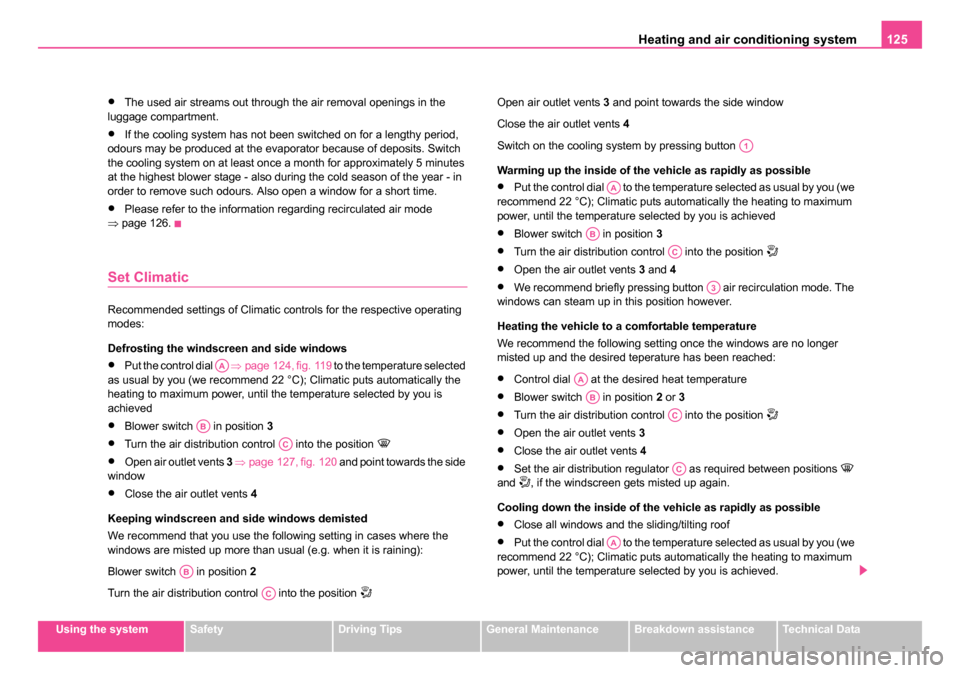
Heating and air conditioning system 125
Using the systemSafetyDriving TipsGeneral MaintenanceBreakdown assistanceTechnical Data
•The used air streams out through the air removal openings in the
luggage compartment.
•If the cooling system has not been switched on for a lengthy period,
odours may be produced at the evaporator because of deposits. Switch
the cooling system on at least once a month for approximately 5 minutes
at the highest blower stage - also during the cold season of the year - in
order to remove such odours. Also open a window for a short time.
•Please refer to the information regarding recirculated air mode
⇒ page 126.
Set Climatic
Recommended settings of Climatic controls for the respective operating
modes:
Defrosting the windscreen and side windows
•Put the control dial ⇒page 124, fig. 119 to the temperature selected
as usual by you (we recommend 22 °C); Climatic puts automatically the
heating to maximum power, until the temperature selected by you is
achieved
•Blower switch in position 3
•Turn the air distribution control into the position
•Open air outlet vents 3 ⇒ page 127, fig. 120 and point towards the side
window
•Close the air outlet vents 4
Keeping windscreen and side windows demisted
We recommend that you use the following setting in cases where the
windows are misted up more than usual (e.g. when it is raining):
Blower switch in position 2
Turn the air distribution control into the position
Open air outlet vents 3 and point towards the side window
Close the air outlet vents 4
Switch on the cooling system by pressing button
Warming up the inside of the vehicle as rapidly as possible
•Put the control dial to the temperature selected as usual by you (we
recommend 22 °C); Climatic puts au tomatically the heating to maximum
power, until the temperature selected by you is achieved
•Blower switch in position 3
•Turn the air distribution control into the position
•Open the air outlet vents 3 and 4
•We recommend briefly pressing button air recirculation mode. The
windows can steam up in this position however.
Heating the vehicle to a comfortable temperature
We recommend the following setting once the windows are no longer
misted up and the desired teperature has been reached:
•Control dial at the desired heat temperature
•Blower switch in position 2 or 3
•Turn the air distribution control into the position
•Open the air outlet vents 3
•Close the air outlet vents 4
•Set the air distribution regulator as required between positions
and , if the windscreen gets misted up again.
Cooling down the inside of the vehicle as rapidly as possible
•Close all windows and the sliding/tilting roof
•Put the control dial to the temperature selected as usual by you (we
recommend 22 °C); Climatic puts au tomatically the heating to maximum
power, until the temperature selected by you is achieved.
AA
AB
AC
AB
AC
A1
AA
AB
AC
A3
AA
AB
AC
AC
AA
s24s.book Page 125 Thursday, November 24, 2005 12:27 PM
Page 128 of 315
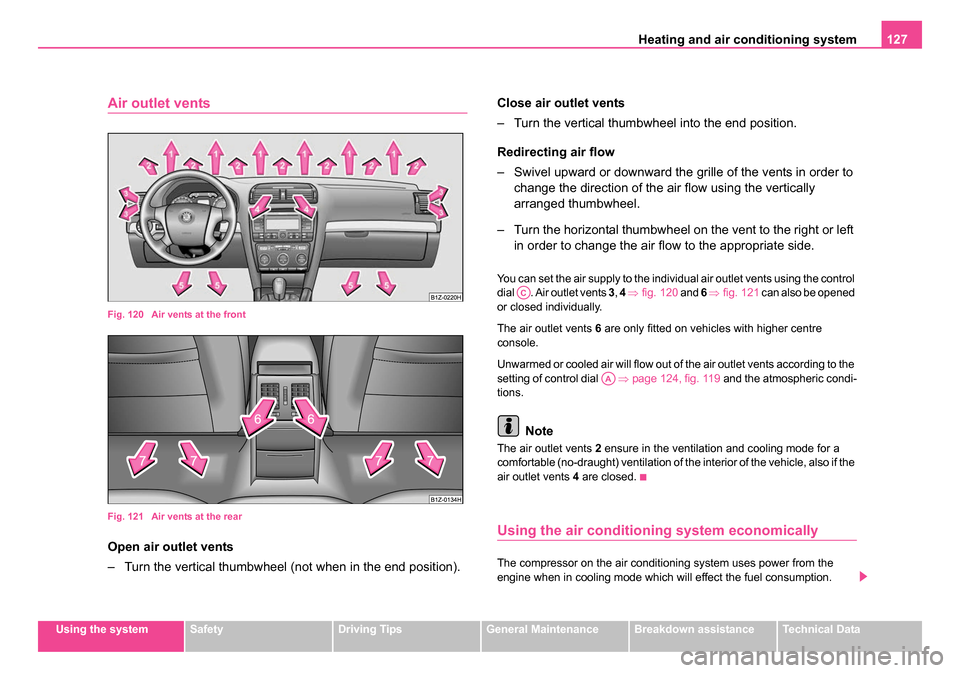
Heating and air conditioning system 127
Using the systemSafetyDriving TipsGeneral MaintenanceBreakdown assistanceTechnical Data
Air outlet vents
Fig. 120 Air vents at the front
Fig. 121 Air vents at the rear
Open air outlet vents
– Turn the vertical thumbwheel (not when in the end position). Close air outlet vents
– Turn the vertical thumbwheel into the end position.
Redirecting air flow
– Swivel upward or downward the gr
ille of the vents in order to
change the direction of the air flow using the vertically
arranged thumbwheel.
– Turn the horizontal thumbwheel on the vent to the right or left in order to change the air flow to the appropriate side.
You can set the air supply to the individual air outlet vents using the control
dial . Air outlet vents 3, 4 ⇒ fig. 120 and 6 ⇒ fig. 121 can also be opened
or closed individually.
The air outlet vents 6 are only fitted on vehicles with higher centre
console.
Unwarmed or cooled air will flow out of the air outlet vents according to the
setting of control dial ⇒page 124, fig. 119 and the atmospheric condi-
tions.
Note
The air outlet vents 2 ensure in the ventilation and cooling mode for a
comfortable (no-draught) ventilation of the interior of the vehicle, also if the
air outlet vents 4 are closed.
Using the air conditioni ng system economically
The compressor on the air conditioning system uses power from the
engine when in cooling mode which will effect the fuel consumption.
AC
AA
s24s.book Page 127 Thursday, November 24, 2005 12:27 PM
Page 130 of 315
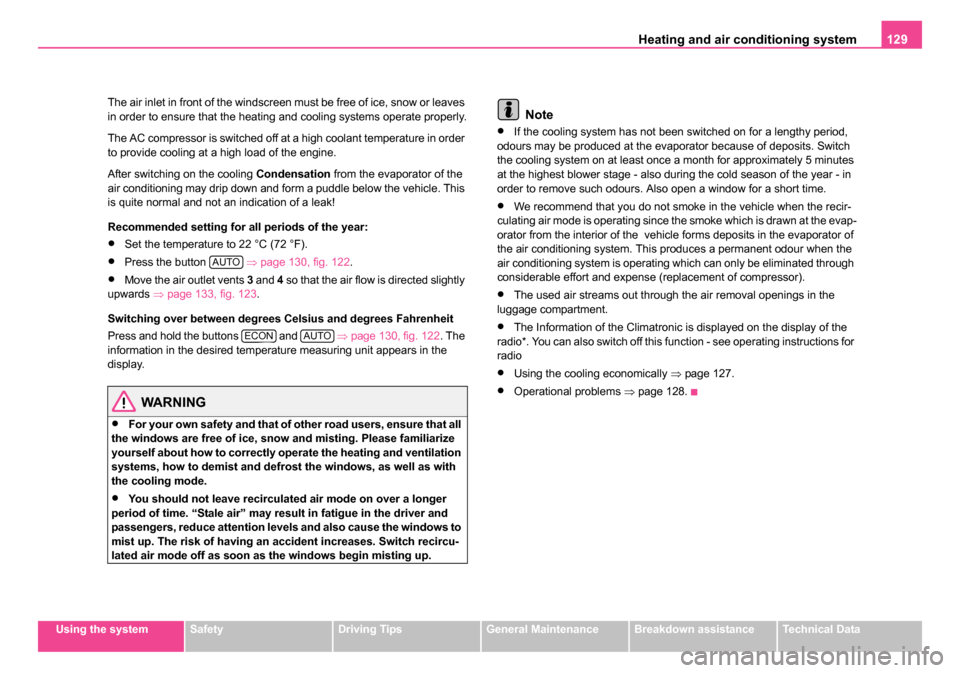
Heating and air conditioning system 129
Using the systemSafetyDriving TipsGeneral MaintenanceBreakdown assistanceTechnical Data
The air inlet in front of the windscreen must be free of ice, snow or leaves
in order to ensure that the heating and cooling systems operate properly.
The AC compressor is switched off at a high coolant temperature in order
to provide cooling at a high load of the engine.
After switching on the cooling
Condensation from the evaporator of the
air conditioning may drip down and form a puddle below the vehicle. This
is quite normal and not an indication of a leak!
Recommended setting for all periods of the year:
•Set the temperature to 22 °C (72 °F).
•Press the button ⇒page 130, fig. 122 .
•Move the air outlet vents 3 and 4 so that the air flow is directed slightly
upwards ⇒page 133, fig. 123 .
Switching over between degrees Celsius and degrees Fahrenheit
Press and hold the buttons and ⇒page 130, fig. 122 . The
information in the desired temperature measuring unit appears in the
display.
WARNING
•For your own safety and that of other road users, ensure that all
the windows are free of ice, snow and misting. Please familiarize
yourself about how to correctly operate the heating and ventilation
systems, how to demist and defrost the windows, as well as with
the cooling mode.
•You should not leave recirculated air mode on over a longer
period of time. “Stale air” may result in fatigue in the driver and
passengers, reduce attention levels and also cause the windows to
mist up. The risk of having an accident increases. Switch recircu-
lated air mode off as soon as the windows begin misting up.
Note
•If the cooling system has not been switched on for a lengthy period,
odours may be produced at the evaporator because of deposits. Switch
the cooling system on at least once a month for approximately 5 minutes
at the highest blower stage - also during the cold season of the year - in
order to remove such odours. Also open a window for a short time.
•We recommend that you do not smoke in the vehicle when the recir-
culating air mode is operating since the smoke which is drawn at the evap-
orator from the interior of the vehicle forms deposits in the evaporator of
the air conditioning system. This produces a permanent odour when the
air conditioning system is operating which can only be eliminated through
considerable effort and expense (replacement of compressor).
•The used air streams out through the air removal openings in the
luggage compartment.
•The Information of the Climatronic is displayed on the display of the
radio*. You can also switch off this function - see operating instructions for
radio
•Using the cooling economically ⇒page 127.
•Operational problems ⇒page 128.
AUTO
ECONAUTO
s24s.book Page 129 Thursday, November 24, 2005 12:27 PM
Page 132 of 315
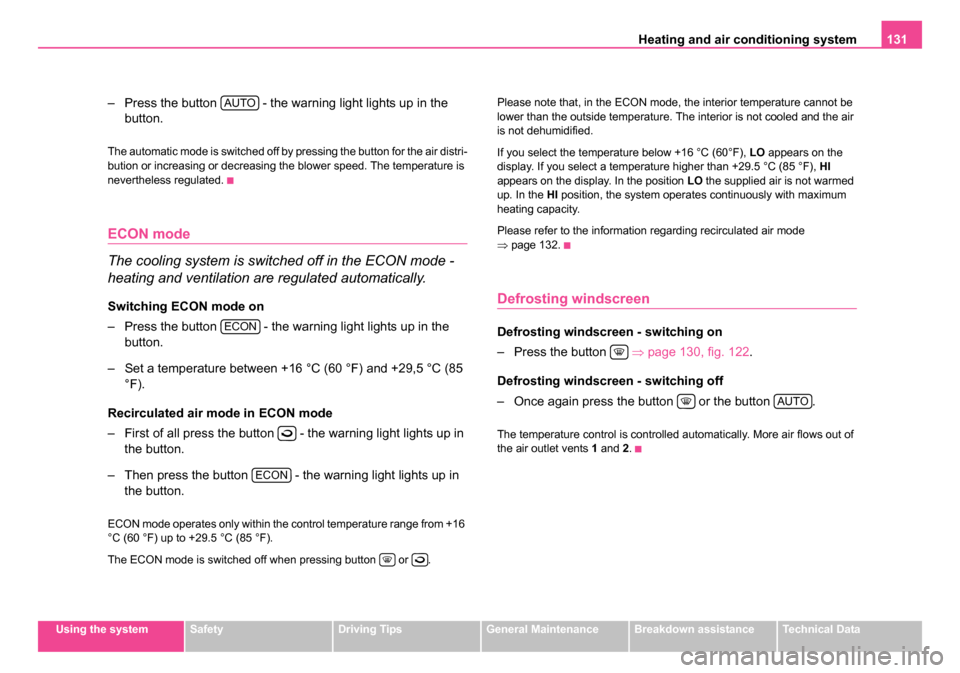
Heating and air conditioning system 131
Using the systemSafetyDriving TipsGeneral MaintenanceBreakdown assistanceTechnical Data
– Press the button - the warning light lights up in the
button.
The automatic mode is switched off by pressing the button for the air distri-
bution or increasing or decreasing the blower speed. The temperature is
nevertheless regulated.
ECON mode
The cooling system is switched off in the ECON mode -
heating and ventilation are regulated automatically.
Switching ECON mode on
– Press the button - the warning light lights up in the button.
– Set a temperature between +16 °C (60 °F) and +29,5 °C (85 °F).
Recirculated air mode in ECON mode
– First of all press the button - the warning light lights up in the button.
– Then press the button - the warning light lights up in the button.
ECON mode operates only within the control temperature range from +16
°C (60 °F) up to +29.5 °C (85 °F).
The ECON mode is switched off when pressing button or . Please note that, in the ECON mode, the interior temperature cannot be
lower than the outside temperature. The interior is not cooled and the air
is not dehumidified.
If you select the temperature below +16 °C (60°F),
LO appears on the
display. If you select a temperature higher than +29.5 °C (85 °F), HI
appears on the display. In the position LO the supplied air is not warmed
up. In the HI position, the system operates continuously with maximum
heating capacity.
Please refer to the information regarding recirculated air mode
⇒ page 132.
Defrosting windscreen
Defrosting windscreen - switching on
– Press the button ⇒page 130, fig. 122 .
Defrosting windscreen - switching off
– Once again press the button or the button .
The temperature control is controlled automatically. More air flows out of
the air outlet vents 1 and 2.
AUTO
ECON
ECON
AUTO
s24s.book Page 131 Thursday, November 24, 2005 12:27 PM
Page 134 of 315
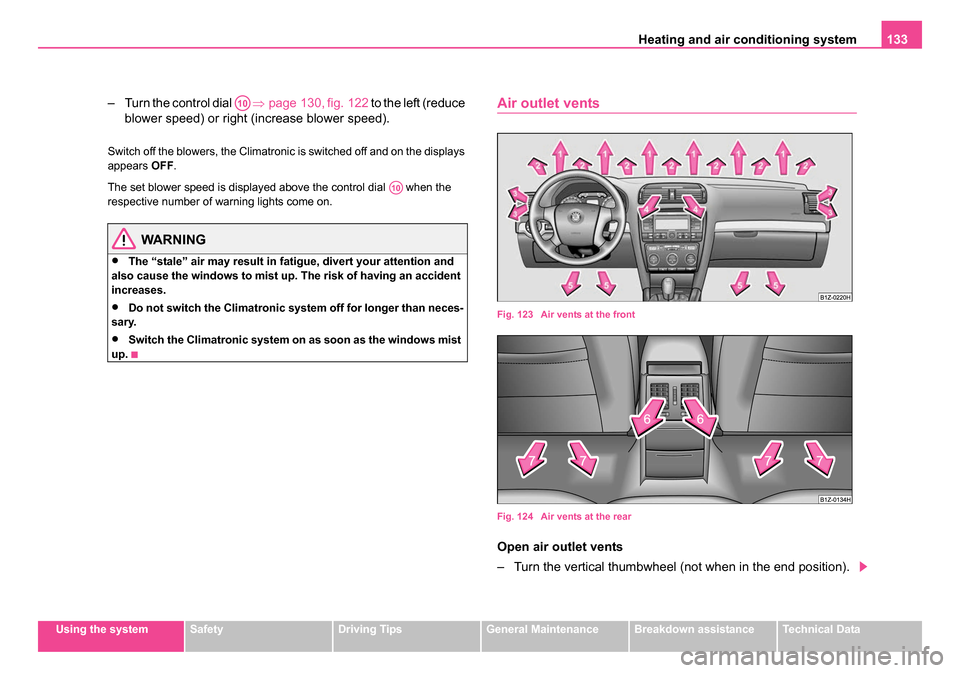
Heating and air conditioning system 133
Using the systemSafetyDriving TipsGeneral MaintenanceBreakdown assistanceTechnical Data
– Turn the control dial ⇒page 130, fig. 122 to the left (reduce
blower speed) or right (increase blower speed).
Switch off the blowers, the Climatronic is switched off and on the displays
appears OFF.
The set blower speed is displayed above the control dial when the
respective number of warning lights come on.
WARNING
•The “stale” air may result in fatigue, divert your attention and
also cause the windows to mist up. The risk of having an accident
increases.
•Do not switch the Climatronic system off for longer than neces-
sary.
•Switch the Climatronic system on as soon as the windows mist
up.
Air outlet vents
Fig. 123 Air vents at the front
Fig. 124 Air vents at the rear
Open air outlet vents
– Turn the vertical thumbwheel (not when in the end position).
A10
A10
s24s.book Page 133 Thursday, November 24, 2005 12:27 PM
Page 136 of 315
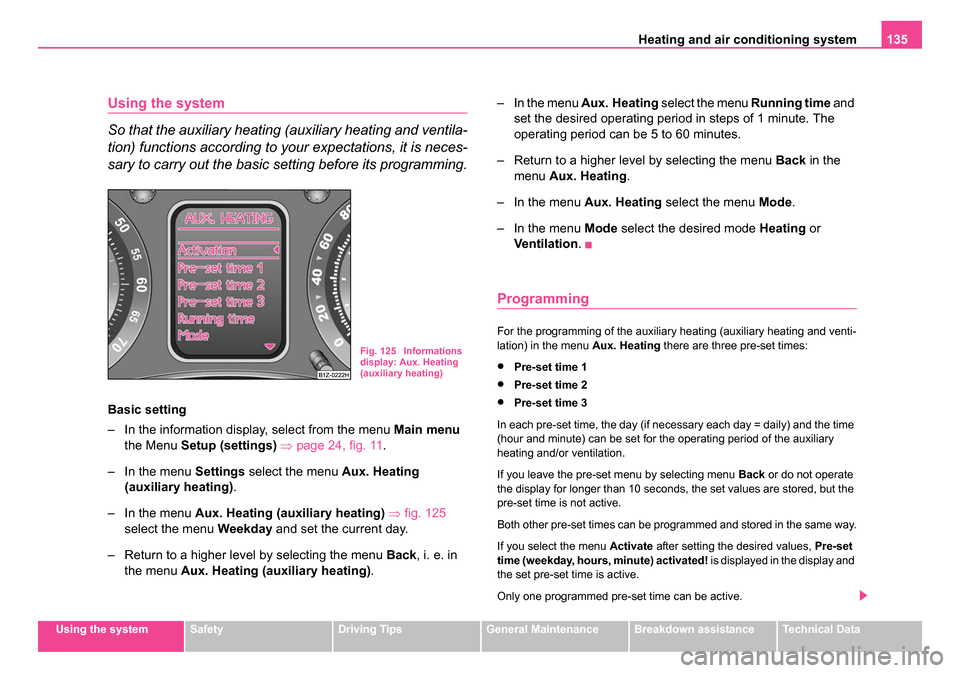
Heating and air conditioning system 135
Using the systemSafetyDriving TipsGeneral MaintenanceBreakdown assistanceTechnical Data
Using the system
So that the auxiliary heating (auxiliary heating and ventila-
tion) functions according to your expectations, it is neces-
sary to carry out the basic setting before its programming.
Basic setting
– In the information display, select from the menu Main menu
the Menu Setup (settings) ⇒ page 24, fig. 11 .
– In the menu Settings select the menu Aux. Heating
(auxiliary heating) .
– In the menu Aux. Heating (auxiliary heating) ⇒ fig. 125
select the menu Weekday and set the current day.
– Return to a higher level by selecting the menu Back, i. e. in the menu Aux. Heating (auxiliary heating) .– In the menu Aux. Heating
select the menu Running time and
set the desired operating period in steps of 1 minute. The
operating period can be 5 to 60 minutes.
– Return to a higher level by selecting the menu Back in the
menu Aux. Heating.
– In the menu Aux. Heating select the menu Mode.
– In the menu Mode select the desired mode Heating or
Ventilation .
Programming
For the programming of the auxiliary heating (auxiliary heating and venti-
lation) in the menu Aux. Heating there are three pre-set times:
•Pre-set time 1
•Pre-set time 2
•Pre-set time 3
In each pre-set time, the day (if necessary each day = daily) and the time
(hour and minute) can be set for the operating period of the auxiliary
heating and/or ventilation.
If you leave the pre-set menu by selecting menu Back or do not operate
the display for longer than 10 seconds, the set values are stored, but the
pre-set time is not active.
Both other pre-set times can be programmed and stored in the same way.
If you select the menu Activate after setting the desired values, Pre-set
time (weekday, hours, minute) activated! is displayed in the display and
the set pre-set time is active.
Only one programmed pre-set time can be active.
Fig. 125 Informations
display: Aux. Heating
(auxiliary heating)
s24s.book Page 135 Thursday, November 24, 2005 12:27 PM
Page 138 of 315
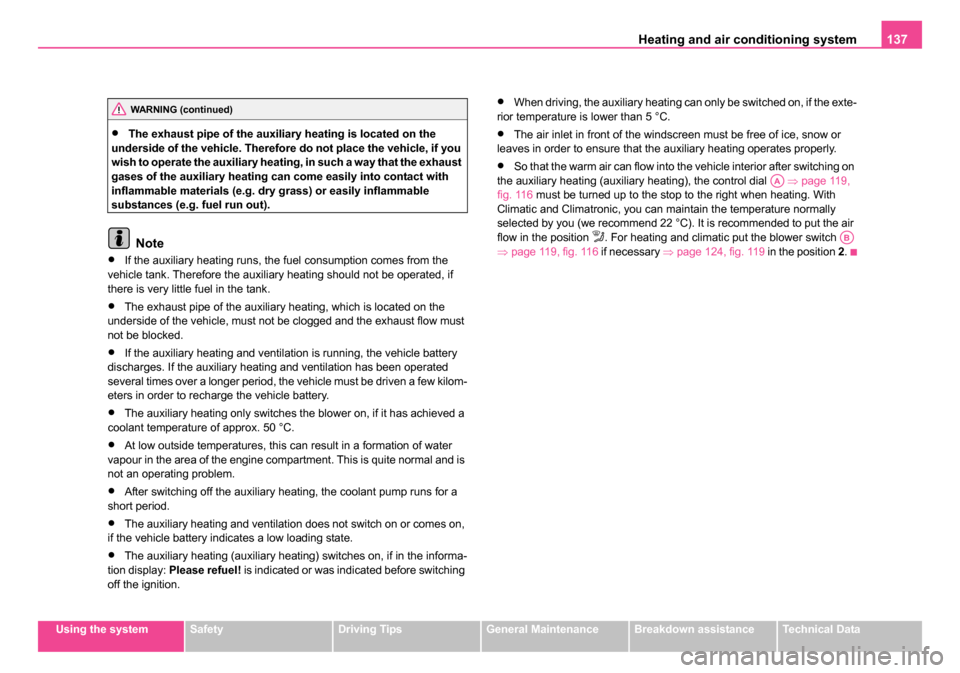
Heating and air conditioning system 137
Using the systemSafetyDriving TipsGeneral MaintenanceBreakdown assistanceTechnical Data
•The exhaust pipe of the auxiliary heating is located on the
underside of the vehicle. Therefore do not place the vehicle, if you
wish to operate the auxiliary heating, in such a way that the exhaust
gases of the auxiliary heating can come easily into contact with
inflammable materials (e.g. dry grass) or easily inflammable
substances (e.g. fuel run out).
Note
•If the auxiliary heating runs, the fuel consumption comes from the
vehicle tank. Therefore the auxiliary heating should not be operated, if
there is very little fuel in the tank.
•The exhaust pipe of the auxiliary heating, which is located on the
underside of the vehicle, must not be clogged and the exhaust flow must
not be blocked.
•If the auxiliary heating and ventilation is running, the vehicle battery
discharges. If the auxiliary heating and ventilation has been operated
several times over a longer period, the vehicle must be driven a few kilom-
eters in order to recharge the vehicle battery.
•The auxiliary heating only switches the blower on, if it has achieved a
coolant temperature of approx. 50 °C.
•At low outside temperatures, this can result in a formation of water
vapour in the area of the engine compartment. This is quite normal and is
not an operating problem.
•After switching off the auxiliary heating, the coolant pump runs for a
short period.
•The auxiliary heating and ventilation does not switch on or comes on,
if the vehicle battery indicates a low loading state.
•The auxiliary heating (auxiliary heating) switches on, if in the informa-
tion display: Please refuel! is indicated or was indicated before switching
off the ignition.
•When driving, the auxiliary heating can only be switched on, if the exte-
rior temperature is lower than 5 °C.
•The air inlet in front of the windscreen must be free of ice, snow or
leaves in order to ensure that the auxiliary heating operates properly.
•So that the warm air can flow into the vehicle interior after switching on
the auxiliary heating (auxiliary heating), the control dial ⇒page 119,
fig. 116 must be turned up to the stop to the right when heating. With
Climatic and Climatronic, you can maintain the temperature normally
selected by you (we recommend 22 °C). It is recommended to put the air
flow in the position
. For heating and climatic put the blower switch
⇒ page 119, fig. 116 if necessary ⇒page 124, fig. 119 in the position 2.
WARNING (continued)
AA
AB
s24s.book Page 137 Thursday, November 24, 2005 12:27 PM
Page 140 of 315
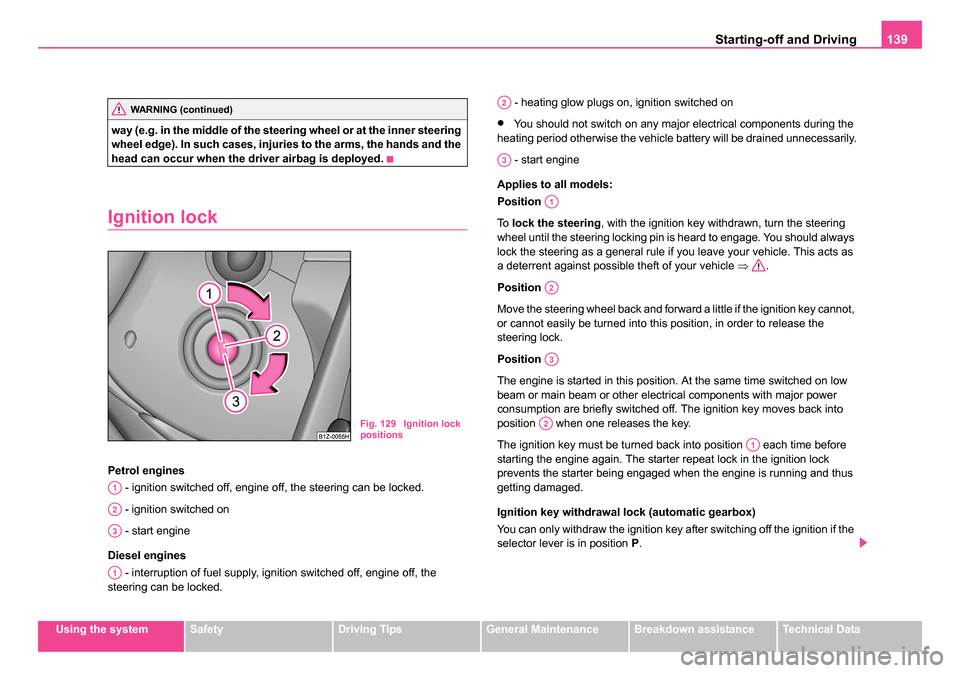
Starting-off and Driving139
Using the systemSafetyDriving TipsGeneral MaintenanceBreakdown assistanceTechnical Data
way (e.g. in the middle of the steering wheel or at the inner steering
wheel edge). In such cases, injuries to the arms, the hands and the
head can occur when the driver airbag is deployed.
Ignition lock
Petrol engines
- ignition switched off, engine off, the steering can be locked.
- ignition switched on
- start engine
Diesel engines - interruption of fuel supply, ignition switched off, engine off, the
steering can be locked. - heating glow plugs on, ignition switched on
•You should not switch on any major electrical components during the
heating period otherwise the vehicle battery will be drained unnecessarily.
- start engine
Applies to all models:
Position
To lock the steering , with the ignition key withdrawn, turn the steering
wheel until the steering locking pin is heard to engage. You should always
lock the steering as a general rule if you leave your vehicle. This acts as
a deterrent against possible theft of your vehicle ⇒.
Position
Move the steering wheel back and forward a little if the ignition key cannot,
or cannot easily be turned into this position, in order to release the
steering lock.
Position
The engine is started in this position. At the same time switched on low
beam or main beam or other electrical components with major power
consumption are briefly switched off. The ignition key moves back into
position when one releases the key.
The ignition key must be turned back into position each time before
starting the engine again. The starter repeat lock in the ignition lock
prevents the starter being engaged when the engine is running and thus
getting damaged.
Ignition key withdrawal lock (automatic gearbox)
You can only withdraw the ignition key after switching off the ignition if the
selector lever is in position P.
WARNING (continued)
Fig. 129 Ignition lock
positions
A1
A2
A3
A1
A2
A3
A1
A2
A3
A2
A1
s24s.book Page 139 Thursday, November 24, 2005 12:27 PM
Page 142 of 315
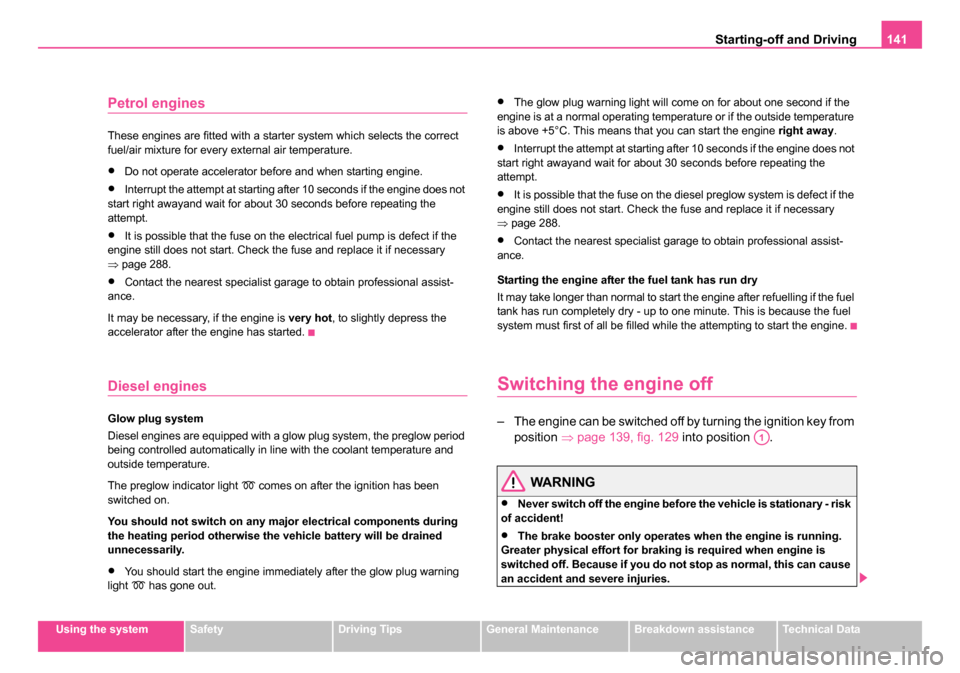
Starting-off and Driving141
Using the systemSafetyDriving TipsGeneral MaintenanceBreakdown assistanceTechnical Data
Petrol engines
These engines are fitted with a starter system which selects the correct
fuel/air mixture for every external air temperature.
•Do not operate accelerator before and when starting engine.
•Interrupt the attempt at starting after 10 seconds if the engine does not
start right awayand wait for about 30 seconds before repeating the
attempt.
•It is possible that the fuse on the electrical fuel pump is defect if the
engine still does not start. Check the fuse and replace it if necessary
⇒ page 288.
•Contact the nearest specialist garage to obtain professional assist-
ance.
It may be necessary, if the engine is very hot, to slightly depress the
accelerator after the engine has started.
Diesel engines
Glow plug system
Diesel engines are equipped with a glow plug system, the preglow period
being controlled automatically in line with the coolant temperature and
outside temperature.
The preglow indicator light
comes on after the ignition has been
switched on.
You should not switch on any major electrical components during
the heating period otherwise the ve hicle battery will be drained
unnecessarily.
•You should start the engine immediately after the glow plug warning
light has gone out.
•The glow plug warning light will come on for about one second if the
engine is at a normal operating temperature or if the outside temperature
is above +5°C. This means that you can start the engine right away.
•Interrupt the attempt at starting after 10 seconds if the engine does not
start right awayand wait for about 30 seconds before repeating the
attempt.
•It is possible that the fuse on the diesel preglow system is defect if the
engine still does not start. Check the fuse and replace it if necessary
⇒ page 288.
•Contact the nearest specialist garage to obtain professional assist-
ance.
Starting the engine after the fuel tank has run dry
It may take longer than normal to start the engine after refuelling if the fuel
tank has run completely dry - up to one minute. This is because the fuel
system must first of all be filled while the attempting to start the engine.
Switching the engine off
– The engine can be switched off by turning the ignition key from position ⇒page 139, fig. 129 into position .
WARNING
•Never switch off the engine before the vehicle is stationary - risk
of accident!
•The brake booster only operates when the engine is running.
Greater physical effort for braking is required when engine is
switched off. Because if you do not stop as normal, this can cause
an accident and severe injuries.
A1
s24s.book Page 141 Thursday, November 24, 2005 12:27 PM
Page 144 of 315
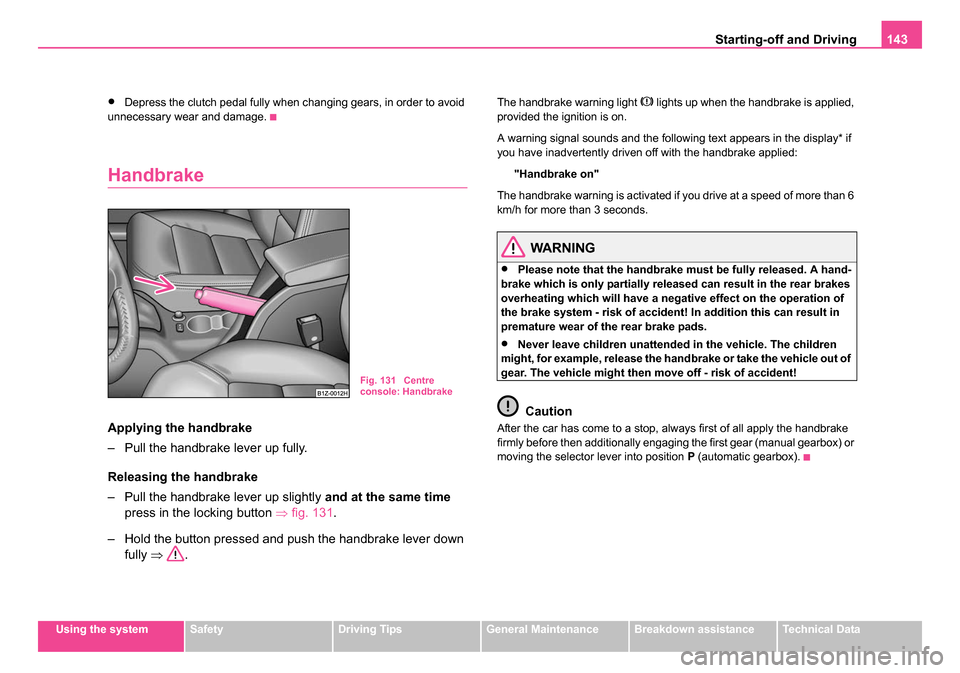
Starting-off and Driving143
Using the systemSafetyDriving TipsGeneral MaintenanceBreakdown assistanceTechnical Data
•Depress the clutch pedal fully when changing gears, in order to avoid
unnecessary wear and damage.
Handbrake
Applying the handbrake
– Pull the handbrake lever up fully.
Releasing the handbrake
– Pull the handbrake lever up slightly and at the same time
press in the locking button ⇒fig. 131 .
– Hold the button pressed and push the handbrake lever down fully ⇒ .
The handbrake warning light lights up when the handbrake is applied,
provided the ignition is on.
A warning signal sounds and the following text appears in the display* if
you have inadvertently driven off with the handbrake applied:
"Handbrake on"
The handbrake warning is activated if you drive at a speed of more than 6
km/h for more than 3 seconds.
WARNING
•Please note that the handbrake must be fully released. A hand-
brake which is only partially released can result in the rear brakes
overheating which will have a nega tive effect on the operation of
the brake system - risk of accident! In addition this can result in
premature wear of the rear brake pads.
•Never leave children unattended in the vehicle. The children
might, for example, release the handbrake or take the vehicle out of
gear. The vehicle might then move off - risk of accident!
Caution
After the car has come to a stop, always first of all apply the handbrake
firmly before then additionally engaging the first gear (manual gearbox) or
moving the selector lever into position P (automatic gearbox).
Fig. 131 Centre
console: Handbrake
s24s.book Page 143 Thursday, November 24, 2005 12:27 PM